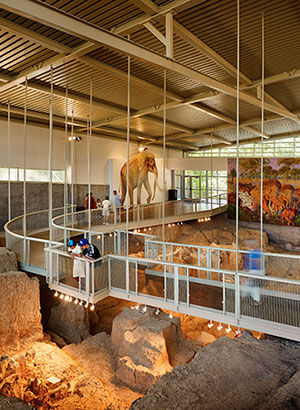WASHINGTON — In a massive expansion of his lands legacy, President Barack Obama on Friday created three new national monuments in Nevada, California and Texas.
Using his authority under the Antiquities Act, the president created a protected area spanning roughly 704,000 acres in central Nevada’s Basin and Range, as well as smaller ones in California’s Berryessa Snow Mountain and Texas’ Waco Mammoth.
With the new designations, Obama has established or expanded 19 national monuments for a total of more than 260 million acres of public lands and waters, more than any previous president. The Basin and Range monument alone, at more than 1,000 square miles, is nearly the size of Rhode Island.
Before Friday Obama had protected 1,142,036 acres of public land; that figure has now nearly doubled, to 2,176,821 acres. He has now bested Teddy Roosevelt in terms of protecting more land under the Antiquities Act, though Presidents Jimmy Carter, Bill Clinton and Franklin D. Roosevelt have put more land off limits to development under the law.
“President Obama’s plan to proclaim new national monuments in Nevada, California, and Texas speaks volumes about the power of local citizens who stand up to protect our public lands,” said Mike Matz, director of Pew’s U.S. public lands program.
The move marks a major victory for retiring Sen. Harry Reid, D-Nev., who had personally lobbied Obama to create the desert monument. The area, which is sparsely populated and undeveloped, serves as a migration corridor for large mammals such as mule deer and pronghorn, as well as habitat for imperiled species including the sage grouse, hoary bat and the flowering White River catseye.
Collin O’Mara, president and CEO of the National Wildlife Federation, said in a statement that “permanent protection for Basin and Range will preserve priority sage grouse habitat at a critical time when we’re all working hard to recover this iconic bird and avoid the need for further protections under the Endangered Species Act.”
Veterans’ groups also lobbied for the designation: Pamela Alfred, a member of the Vet Voice Foundation and resident of Spring Creek, Nevada, said in a statement it was important because “veterans find solace in the Great Outdoors.”
The Basin and Range is significantly larger than the president’s previously biggest national monument, the nearly-500,000-acre Organ Mountains-Desert Peaks in New Mexico. Broadly supported by environmentalists, it is also home to a major earthen sculpture, “City” which the artist Michael Heizer has worked to create over nearly half a century.
With this move, Reid has expanded the scope of protected areas in his home state from roughly 67,000 acres when he took office to nearly 4.7 million acres more than 30 years later.
A White House fact sheet released Friday says “this unbroken expanse attracts recreationists seeking vastness and solitude and provides significant wildlife habitat and migration corridors,” as well as telling “the story of a rich cultural tradition, from the earliest human inhabitants 13,000 years ago to miners and ranchers in the past century.”
But many local office holders and ranchers opposed the designation, arguing it could impede economic development and threaten local grazing operations. While the proclamation stipulates it will not affect any grazing activities in the area Connie Simkins, who serves as secretary as the local grazing board that encompasses one of the affected counties, noted that the creation of the Great Basin National Park ultimately ended grazing there through later regulation.
“We’re scared to death this will be a locked up, worse than wilderness situation,” she said.
Rep. Cresent Hardy, R-Nev., who represents the two counties in which the monument lies, unleashed a series of tweets Friday accusing the president of using his executive authority to do a favor for a close political ally. “Photo opp later today will demonstrate having friends in high places is more important than will of the people,” said one.
The two other designations are less controversial. The new Berryessa Snow Mountain National Monument encompasses nearly 331,000 acres of public land in northern California’s Inner Coast Range, which has markers of Native American history as well as a range of key species. It is threatened by both wine industry development as well as the growing marijuana industry there.
Supporters of the designation included more than 200 local businesses as well local city and county governments and cultural preservation groups.
John Pickerel, owner of Buckhorn Steakhouse in Winters, California, said the move “will enhance recreational opportunities for everyone. It will encourage tourism particularly along scenic Highway 128 from Winters to Napa and create a desirable place for people to live and work.”
Waco Mammoth in Texas ranks as a major paleontological site, featuring well-preserved remains of 24 Columbian Mammoths. The mammoths date back more than 65,000 years, and the site includes the nation’s first and only recorded discovery of a nursery herd of mammoths.
Rep. Bill Flores, R-Texas, has sought to make the area a national monument through legislation, and the site has been developed and protected by the National Park Service, the City of Waco, Baylor University and the Waco Mammoth Foundation.
“This new national monument will benefit the city’s economy as well as schoolchildren, scientists and other visitors to this site,” said Suzanne Dixon, senior director of regional operations for the National Parks Conservation Association. “Waco Mammoth is a window to a world lost long ago, and with this designation, visitors from across the country will be able to continue learning about the science and history of these amazing creatures.
For more information onn the Waco Mammoth Monument
www.nps.gov/waco/index.htm






